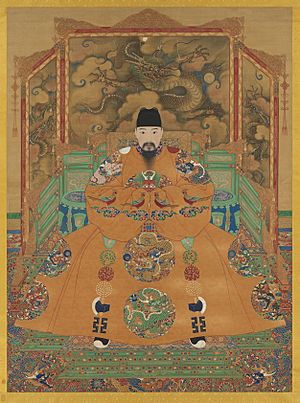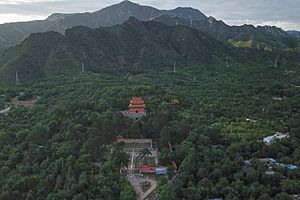Hongzhi Emperor facts for kids
Quick facts for kids Hongzhi Emperor弘治帝 |
|||||||||||||||||
|---|---|---|---|---|---|---|---|---|---|---|---|---|---|---|---|---|---|
 |
|||||||||||||||||
| 10th Emperor of the Ming dynasty | |||||||||||||||||
| Reign | 22 September 1487 – 8 June 1505 | ||||||||||||||||
| Coronation | 22 September 1487 | ||||||||||||||||
| Predecessor | Chenghua Emperor | ||||||||||||||||
| Successor | Zhengde Emperor | ||||||||||||||||
| Born | 30 July 1470 | ||||||||||||||||
| Died | 8 June 1505 (aged 34) | ||||||||||||||||
| Burial | Tailing, Ming tombs, Beijing | ||||||||||||||||
| Consorts |
Empress Xiaochengjing
(m. 1487–1505) |
||||||||||||||||
| Issue | Zhengde Emperor | ||||||||||||||||
|
|||||||||||||||||
| House | House of Zhu | ||||||||||||||||
| Father | Chenghua Emperor | ||||||||||||||||
| Mother | Empress Xiaomu | ||||||||||||||||
The Hongzhi Emperor (Chinese: 弘治; pinyin: Hóngzhì) was the 10th Emperor of the Ming dynasty. He ruled from 1487 to 1505. Born Zhu Youcheng on July 30, 1470, he was the oldest son of the Chenghua Emperor. His time as emperor is known as the "Hongzhi Silver Age."
The name of his era, "Hongzhi," means "great government." He was an emperor who loved peace. The Hongzhi Emperor also had only one wife, the Empress, and no other partners. This makes him special in Chinese history, as most emperors had many wives. He was a ruler during the middle period of the Ming dynasty.
Early Life and Education
Zhu Youcheng was born to Lady Ji. His birth was kept a secret for a long time. He was raised hidden by his mother, the Empress Wu (who had been set aside), and loyal palace helpers. They kept him safe from Consort Wan, another favorite of Emperor Chenghua, who wanted to be the only one to have the emperor's children.
Consort Wan's own child had died soon after birth. Because of this, Zhu Youcheng's existence was a secret for his safety. He was finally reunited with his father in 1475 when he was five years old. After this, he was named the crown prince, meaning he would be the next emperor. He was a very smart child and received the best education available. He studied Confucianism deeply and did very well in his lessons.
Ruling as Emperor
When the Hongzhi Emperor became ruler in 1487, he based his government on Confucian ideas. He was a very hard-working and careful emperor. He watched over all government matters closely. He also lowered taxes for the people and spent less money on government expenses.
He made smart choices when picking people to work in his government. Important officials like Liu Jian, Xie Qian, and Wang Shu worked closely with him. This created a rare time of teamwork within the government. The emperor also encouraged his officials to speak openly about any problems. He even welcomed criticism directed at himself.
This made the government more open and brought new energy to the Ming dynasty. As a result, the people became prosperous again under his rule. It is said that the power of individual palace helpers was limited. Also, the tricky plots often seen in earlier reigns were not present during his time. The Hongzhi Emperor is often compared to the Hongwu Emperor and Yongle Emperor. These three are considered some of the most brilliant emperors of the Ming dynasty.
In the spring of 1488, a group of sailors from Joseon (Korea) were shipwrecked. They were traveling up the Grand Canal in China, being helped by Ming officials to return home. One of the Koreans, Choe Bu, saw many ships carrying officials from different government departments. When he asked what was happening, he learned that the new Hongzhi Emperor was removing corrupt and unfit officials. The ships were a kind gesture from the emperor, giving them a comfortable way to go home.
The Hongzhi Emperor's policies were also very accepting of Islam and Chinese Muslims. An Ottoman geographer named Ali Akbar Khata'i wrote about the good relationship between the emperor and the Muslim community in China. Akbar mentioned that the emperor had many Muslims working in his court.
Succession and Family
Unlike most emperors before and after him, the Hongzhi Emperor had only one Empress during his life. Empress Zhang had only two sons, and one of them died when he was a baby. This meant the Hongzhi Emperor had only one son left to take over the throne.
After the emperor passed away in 1505, his son, the Zhengde Emperor, became the next ruler. Sadly, the Zhengde Emperor died in 1521 without any children. Because of this, the throne had to go to a cousin from Hubei, named Zhu Houcong. This meant that the Hongzhi Emperor's direct family line of succession ended.
See also
 In Spanish: Hongzhi para niños
In Spanish: Hongzhi para niños



